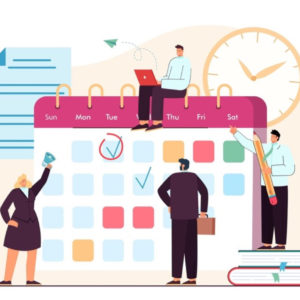
09 Aug 2-2-3 Schedule: Everything You Need To Know About This Schedule
What is the 2-2-3 work schedule?
The 2-2-3 work schedule, often referred to as the “every other weekend off” schedule, is a type of rotating shift schedule commonly used in 24/7 operations. The basic premise is that employees work for two days, have two days off, work for three days, and then have two days off again, rotating in this pattern. The schedule ensures continuous coverage while also giving employees a consistent pattern of work and rest days.
If we assume that each “Work” shift is a 12-hour duration (which is common for 24/7 operations using the 2-2-3 schedule), then the table can be modified to include the work duration for Team 1 and Team 2.
For simplicity, let’s assume Team 1 works the day shift (e.g., 7:00 AM to 7:00 PM) and Team 2 works the night shift (e.g., 7:00 PM to 7:00 AM).
Here’s how the table would look:
| Day | Week 1 – Team 1 | Week 1 – Team 2 | Week 2 – Team 1 | Week 2 – Team 2 |
|---|---|---|---|---|
| Monday | Work (7 AM – 7 PM) | Off | Off | Work (7 PM – 7 AM) |
| Tuesday | Work (7 AM – 7 PM) | Off | Off | Work (7 PM – 7 AM) |
| Wednesday | Off | Work (7 PM – 7 AM) | Work (7 AM – 7 PM) | Off |
| Thursday | Off | Work (7 PM – 7 AM) | Work (7 AM – 7 PM) | Off |
| Friday | Work (7 AM – 7 PM) | Off | Off | Work (7 PM – 7 AM) |
| Saturday | Work (7 AM – 7 PM) | Off | Off | Work (7 PM – 7 AM) |
| Sunday | Work (7 AM – 7 PM) | Work (7 PM – 7 AM) | Work (7 AM – 7 PM) | Work (7 PM – 7 AM) |
Then the cycle repeats.
One of the benefits of this schedule is that employees get every other weekend off, which can be appealing for work-life balance. However, the long stretches of work days can be tiring, especially if the shifts are 12 hours long.
To cover a full 24/7 operation with this schedule, you’d typically need four teams or groups of employees. Two teams would be on duty while the other two are off, and they’d rotate according to the 2-2-3 pattern.
What are the advantages of the 2-2-3 schedule?
The 2-2-3 schedule, often used in 24/7 operations, offers several advantages for both employers and employees:
Consistent Rotation:
The 2-2-3 schedule provides a predictable rotation, making it easier for employees to plan their personal lives around their work schedules.
Every Other Weekend Off:
Employees get every other full weekend off, which can be more favorable than other rotating schedules that might not guarantee any full weekends off.
Long Breaks:
After every two or three workdays, employees get a two-day break. This can be refreshing and can help reduce burnout.
Fewer Shift Changes:
With 12-hour shifts, there are fewer shift changes compared to 8-hour shifts. This can lead to fewer handoff-related errors in industries where continuity is crucial, like healthcare or manufacturing.
Longer Workdays but Fewer Workdays:
While 12-hour shifts are longer, employees work fewer days in a week. This can result in fewer commutes and more consecutive days off, which some people prefer.
Full Coverage:
For employers, the 2-2-3 schedule ensures that there’s always someone working, which is essential for 24/7 operations.
Reduced Overtime:
With a well-planned 2-2-3 schedule, employers can reduce the need for unexpected overtime, as the schedule inherently covers all hours.
Employee Satisfaction:
Many employees appreciate the longer breaks and consistent schedule, leading to increased job satisfaction.
Training and Skill Development:
With fewer shift changes, there’s more continuous time for training and skill development during the shift.
Flexibility:
For some operations, having employees on a 12-hour shift can provide flexibility in managing workload peaks and valleys.
However, it’s worth noting that the 2-2-3 schedule also has its challenges. The long 12-hour shifts can be tiring, and not everyone can adapt easily to such long workdays. It’s essential to weigh the advantages against the potential drawbacks when considering implementing this schedule.
What are the disadvantages of the 2-2-3 schedule?
While the 2-2-3 schedule offers several advantages, it also comes with potential disadvantages:
Long Workdays in the 2-2-3 schedule:
12-hour shifts can be exhausting, both physically and mentally. This can be especially challenging in high-stress or physically demanding jobs.
Health Concerns:
Extended work hours can lead to fatigue, increased stress, sleep disturbances, and other health issues. Over time, this can increase the risk of chronic health problems.
Also Read: Research by NCIB on 12-hour shifts.
Work-Life Balance:
While the schedule provides long breaks, the workdays themselves can be so long that employees might feel they have little time for personal or family activities on those days.
Safety Concerns:
Fatigue from long shifts can lead to decreased alertness and increased risk of accidents or mistakes, especially in safety-critical industries.
Reduced Handovers:
While fewer handovers can be seen as an advantage, it can also be a disadvantage. If something critical is missed during a shift change, it might not be addressed for a longer period compared to shorter shifts.
Potential for Burnout:
Even with breaks, the intensity of working several 12-hour shifts in a row can lead to quicker burnout for some employees.
Also Read: How to prevent employee burnout.
Less Flexibility for Part-time Workers:
The 2-2-3 schedule may not be as accommodating for part-time workers or those who prefer shorter shifts.
Childcare and Family Concerns:
For parents or caregivers, 12-hour shifts can pose challenges in coordinating childcare or attending to family needs.
Potential for Overtime:
If an employee calls in sick or cannot attend their 12-hour shift for some reason, filling that gap can require another employee to work overtime, which can be costly for employers.
Adaptation Period:
Transitioning to a 2-2-3 schedule from a traditional 8-hour shift pattern can require an adjustment period for employees, leading to initial resistance or discomfort.
Consistency in Work Quality:
As employees approach the end of a long 12-hour shift, their productivity and work quality might decline due to fatigue.
When considering the 2-2-3 schedule, it’s essential for organizations to weigh these disadvantages against the advantages and consider the specific needs and preferences of their workforce.
Which industries typically use the 2-2-3 schedule?
The 2-2-3 schedule is commonly used in industries that require 24/7 operations. Some of these industries include:
Healthcare:
Hospitals and other healthcare facilities often need continuous staffing. Nurses, technicians, and other healthcare professionals might work on this schedule to ensure round-the-clock patient care.
Emergency Services:
Firefighters, emergency medical technicians, and paramedics might work on a 2-2-3 or similar rotating schedule to ensure there’s always a team available for emergencies.
Law Enforcement:
Some police departments and correctional facilities use 12-hour shifts to ensure continuous coverage.
Manufacturing:
Plants that operate 24/7 to maximize production often use the 2-2-3 schedule. Continuous operations can be more efficient and cost-effective than starting and stopping production.
Utilities:
Power plants, water treatment facilities, and other utility services that need to operate continuously might employ workers on a 2-2-3 schedule.
Oil and Gas:
Offshore oil rigs and refineries, which operate non-stop, often use 12-hour shift patterns, including the 2-2-3 schedule.
Transportation:
Some transportation hubs, like major train or bus stations, might use this schedule to ensure continuous operations.
Customer Support and Call Centers:
Companies that offer 24/7 customer support might use the 2-2-3 schedule to ensure there’s always staff available to assist customers.
Data Centers:
With the need for continuous monitoring and maintenance, data centers might employ technicians on a 2-2-3 schedule.
Security:
Security personnel in settings that require 24/7 surveillance, such as casinos, malls, or gated communities, might work on this schedule.
Mining:
Mining operations, especially those in remote locations, might use a 2-2-3 schedule or similar to maximize production.
How to create a supportive environment for 12 hours shifts and the 2-2-3 schedule?
Working 12-hour shifts in a 2-2-3 schedule can be demanding for employees. To ensure comfort, productivity, and overall well-being, employers can adopt several strategies:
Adequate Breaks:
Ensure that employees have regular breaks during their shifts. This includes both short breaks for relaxation and longer breaks for meals.
Ergonomic Workspaces:
Design workspaces that minimize physical strain. This includes ergonomic chairs, adjustable desks, proper lighting, and other tools that make tasks easier and more comfortable.
Healthy Meals and Snacks:
Offer nutritious meals and snacks in the workplace. This can help maintain energy levels and prevent fatigue.
Hydration Stations:
Ensure that clean drinking water is readily available. Staying hydrated is crucial, especially during longer shifts.
Training:
Provide training on the importance of sleep, nutrition, and self-care. Educate employees on how to manage the demands of longer shifts.
Flexible Scheduling:
If possible, allow some flexibility in start and end times or in choosing preferred shifts. This can help employees balance personal and work commitments.
Rotation of Tasks:
Rotate employees through different tasks or roles during their shift to prevent monotony and reduce the risk of repetitive strain injuries.
Supportive Management:
Managers should be trained to recognize signs of fatigue or burnout and to offer support when needed. Open communication channels can help address any concerns promptly.
Mental Health Resources:
Offer resources or programs that support mental well-being, such as counseling services or stress-relief activities.
Rest Areas:
Create quiet, comfortable spaces where employees can relax during their breaks. This can be especially beneficial for those in high-stress roles.
Feedback Mechanism:
Regularly solicit feedback from employees about the schedule and working conditions. This can help identify areas for improvement.
Shift Handovers:
Ensure that there’s a structured and efficient process for handing over tasks between shifts. This can reduce the risk of errors and ensure continuity.
Safety Protocols:
Emphasize the importance of safety, especially in roles where fatigue can lead to accidents. Regular safety training and reminders can help.
Recognition and Rewards:
Recognize and reward employees for their hard work and commitment. This can boost morale and motivation.
Health and Wellness Programs:
Offer programs that promote physical health, such as gym memberships, health screenings, or wellness seminars.
Childcare Services:
Consider offering childcare services or support, especially for employees who might find it challenging to manage childcare during long shifts.
Transportation:
For shifts that end late at night or start early in the morning, consider providing transportation or transportation allowances.
By implementing these strategies, employers can create a more supportive environment for employees working 12-hour shifts in a 2-2-3 schedule, leading to increased satisfaction, productivity, and retention.
The 2-2-3 work schedule, characterized by its 12-hour shifts and rotating pattern, is a popular choice for industries requiring 24/7 operations. While it offers several advantages, such as consistent rotation, every other weekend off, and fewer workdays in a week, it also presents challenges due to the extended work hours.
For employers to maximize the benefits of this schedule and ensure the well-being of their employees, it’s crucial to implement supportive measures. These can range from ergonomic workspaces and regular breaks to mental health resources and flexible scheduling. By proactively addressing the unique demands of this schedule, employers can foster a productive, satisfied, and resilient workforce.




